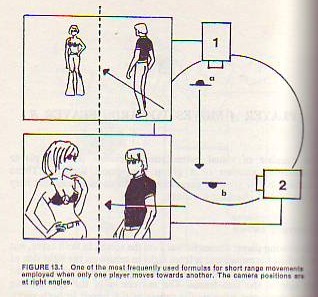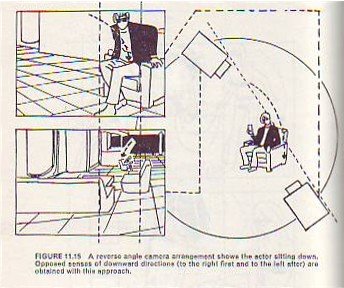 This is the best film book I know of: "Grammar of the Film Language" by D. Arijon. Too many film books waste the readers time with personal anecdotes and academic jargon. A lot of this book is made up of diagrams and captions and usually you can tell what's going on without reading the captions.
This is the best film book I know of: "Grammar of the Film Language" by D. Arijon. Too many film books waste the readers time with personal anecdotes and academic jargon. A lot of this book is made up of diagrams and captions and usually you can tell what's going on without reading the captions.The book starts with simple set-ups like the one above. I love back shots where the actor walks away from camera into the set and seems to take you with him. We cut to a side shot to pick up the actor entering sc on a close shot. It's a challenging cut but one which is never jarring or confusing.
 Arijon likes to cut to actors who are in the same quadrant of the screen that they were in on the previous shot. Is this standard practice or just a preference of the author?
Arijon likes to cut to actors who are in the same quadrant of the screen that they were in on the previous shot. Is this standard practice or just a preference of the author?
 Here's a nifty way to walk a man down a corridor. I like the the way the third shot, where he presumably stops, deliberately violates the screen direction of the previous two shots.
Here's a nifty way to walk a man down a corridor. I like the the way the third shot, where he presumably stops, deliberately violates the screen direction of the previous two shots.
A lot of the set-ups in the book are more complicated than the ones I've shown here, but most of them are understandable without recourse to the text. Skillfully done drawings will often explain things faster and better than text. It's amazing that more books aren't presented this way.
A word about Arijon: he was a filmmaker and teacher in Uruguay when he published this book in the mid-70s. Can you imagine that!? It took someone from Uruguay to show us how to write a textbook the right way!

9 comments:
Hey Eddie,
That cutting theory about having the character in the same part of the screen between cuts was told to me by an ex-disney director...I guess it makes sense if the scenes require some sort of relation between eachother and it softens the cut, BUT he stuck to it like it was holy scripture, even when it didn't make sense at all...I think it was one of those theories that somehow became a fixed RULE in his mind and he never questioned it. It made working for him very frustrating....
Actually, I think a good rule of thumb when creating any art, film or otherwise, comes from (of all places) Eddie Murphy's flop film The Golden Child. When Eddie is sent on a task to retrieve a daggar that's located at the end of a steep and narrow bridge all while carrying a glass of water (which he is told not to spill even a drop of) by an old Chinese mystic, before he ventures out he's told "follow the instructions closely but also know when to break the rules".
I think everyone who works in any artform should learn that. They should know when to follow the rules and know when to break them.
Nick, I couldn't agree more with your anecdote--the spirit of it; I've had a lot of fun seeing all kinds of great animation and liveaction shots that should be "wrong" as per the "rules", but work well....there literally is no dogma in filmmaking(or shouldn't be)--if it works!
JL: Of course Nick is right to criticize people who do everything by the book, whether it fits or not, but I think we're all curious to know what's in the book.
I wish there was a site where knowledgable live action people would use YouTube clips to analyze classic film sequences in depth. You get a little of that in DVD audio commentaries but the film is always running in real time on those discs so the commenters have to race through it.
This is the sort of thing we did in a concept class I was taking. We would have to take a sequence in a film and draw it out completely, each camera angle, movement, and action done by the actors in order to understand what is really going on. Pictorial diagrams communicate on such an easier level - that's why every filmmaker should make storyboards or hire a storyboard artist (well everyone except Cassavettes!!)
Eddie, let's find some Uruguay movies to watch!
ps- i still think oh doctor had some good parts haha
Careful Kali... it seems that anyone associated with John K deeply despises anyone who is attending film school... not sure how Eddie feels about this, but John seems to think that only gay males take film and animation classes.
"Careful Kali... it seems that anyone associated with John K deeply despises anyone who is attending film school... not sure how Eddie feels about this, but John seems to think that only gay males take film and animation classes."
Haha- I don't think that's true at all. I'm pretty sure they don't think of me as a gay male! But thanks for your concern Anonymous...
An extraordinary example of unorthodox cuts and rule breaking is Carl Th.Dreyer's "The Passion of Joan d'Arc". Dreyer deliberately violated not only the 180 degrees rule, but also nearly every other filmmaking rule known at that time, and yet the effect is absolutely stunning. This film gives to the spectator one of the most powerful experiences in the history of cinema.
'Carl Th.Dreyer's "The Passion of Joan d'Arc"...one of the most powerful experiences in the history of cinema'
I agree completely! That movie is so good- and breaks all the rules- great example!
Post a Comment